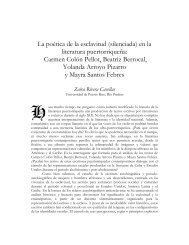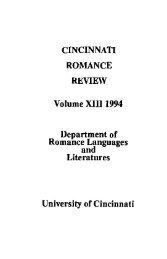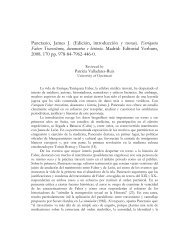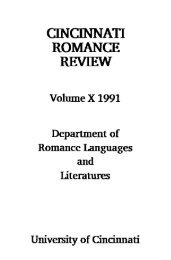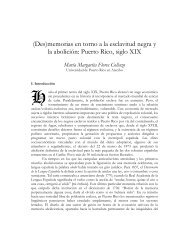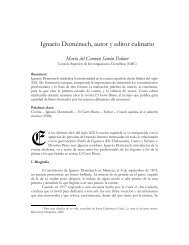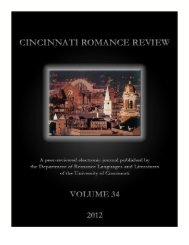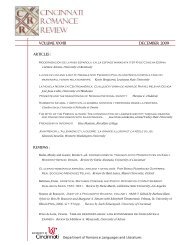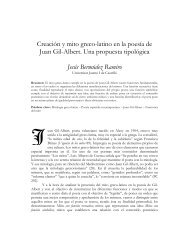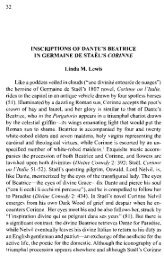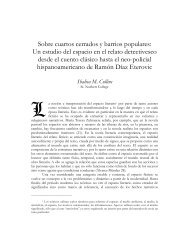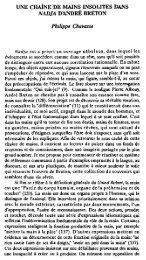Volume 30 (2011) - Cincinnati Romance Review
Volume 30 (2011) - Cincinnati Romance Review
Volume 30 (2011) - Cincinnati Romance Review
You also want an ePaper? Increase the reach of your titles
YUMPU automatically turns print PDFs into web optimized ePapers that Google loves.
WRITING AFRICANS OUT OF THE RACIAL HIERARCHY<br />
a means of ultimately eliminating them, and of “lightening” Mexico’s racial stock by<br />
avoiding acknowledging the presence of people of African descent in Mexico’s<br />
population and history.<br />
This study consciously focuses on three individuals who at various times in their<br />
lives worked for branches of the Mexican government (usually educational) and in some<br />
cases even founded government institutions based on their ideas. Despite their antiimperialist,<br />
nationalist mentalities, all three spent periods of time living in the United<br />
States, often seeking refuge when their ideas fell out of favor with their own<br />
government. Both their experiences in the U.S. and the influence of North Atlantic<br />
ideas on their educations are significant for understanding each of these men’s<br />
assertions about race, and particularly their decision to render invisible Afro-Mexicans<br />
by writing them out of treatises on Mexico’s future. In contrast to the científicos who<br />
worked during the Porfiriato, these 20th century Mexican intellectuals considered<br />
themselves nationalists and intended their visions of the Mexican people’s future to<br />
counter the white supremacist ideology supported by Social Darwinism and embraced<br />
by U.S. intellectuals. Yet in ignoring the historical presence of Africans throughout<br />
Mexican history, Mexican intellectuals reified the North Atlantic vision of a racial<br />
hierarchy with Anglo-Europeans and Anglo-Americans at the top and Africans and<br />
indigenous Americans at the bottom. Many recent scholars have pointed out the racism<br />
inherent to the concept of mestizaje. 2 However, these critiques have focused on Mexican<br />
intellectuals’ treatment of indigenous people. Emphasizing the exclusion of Africans<br />
from the racial narratives underlines the nuances of Mexican racism in the first half of<br />
the 20th century. It also suggests how firmly entrenched North Atlantic ideas about race<br />
had become in Mexico by the 20th century.<br />
Anti-African Sentiment<br />
The history of Africans in Mexico spans as far back as the history of Europeans<br />
there. Africans took part in the conquest of Mexico and were present throughout the<br />
colonial period. Often they held significant intermediary roles as overseers, skilled<br />
craftsmen, and merchants. Both free and enslaved Africans could be found in colonial<br />
Mexico. As the colonial period progressed, Spaniards imported more African slaves to<br />
work as unskilled laborers in the semi-tropical sugar-producing regions around<br />
Veracruz, Acapulco, and parts of Guerrero and Oaxaca. Because more male than female<br />
slaves were imported, interracial unions regularly occurred in the colonial period,<br />
particularly between indigenous women and African men. As a result of the decline of<br />
slavery combined with racial mixing, by the time of independence only a small portion<br />
(2004).<br />
2 In addition to the authors listed above, see Alan Knight (1990) and Marilyn Grace Miller<br />
<strong>Cincinnati</strong> <strong>Romance</strong> <strong>Review</strong> <strong>30</strong> (Winter <strong>2011</strong>): 172-183.<br />
173



